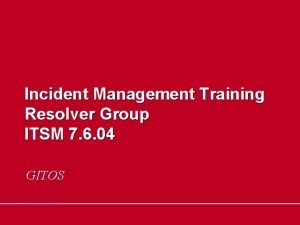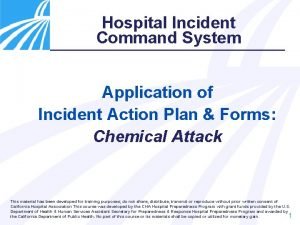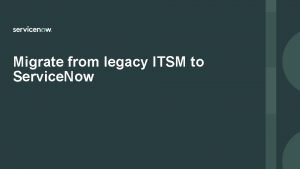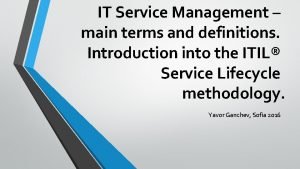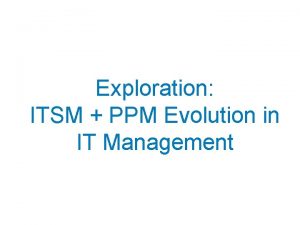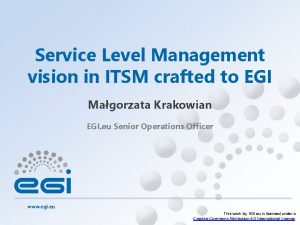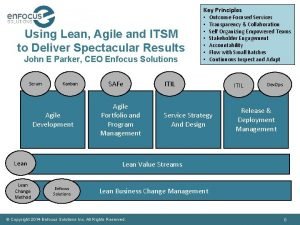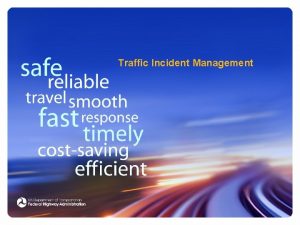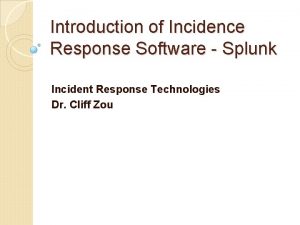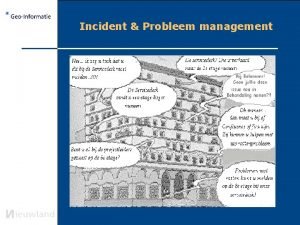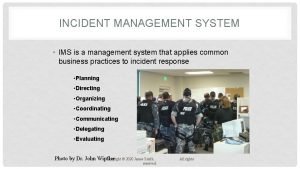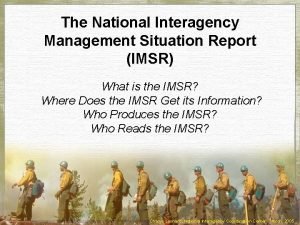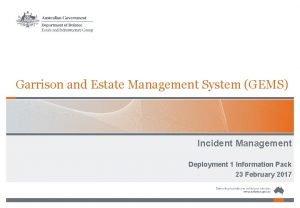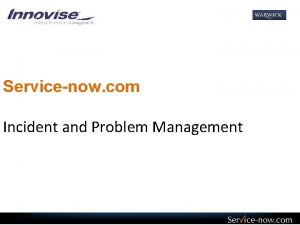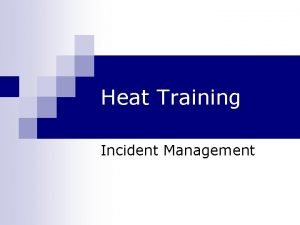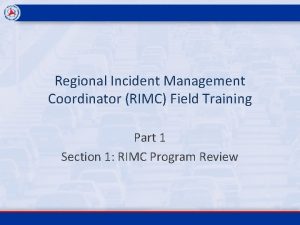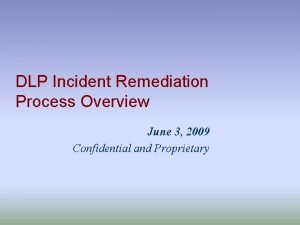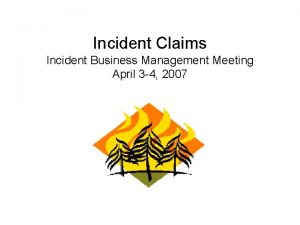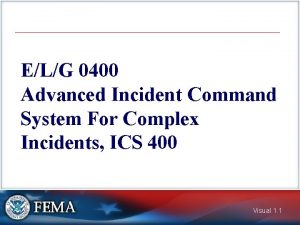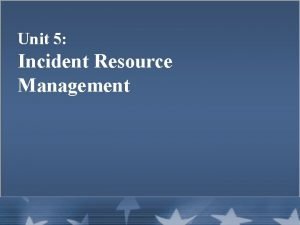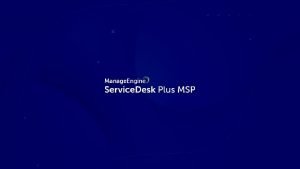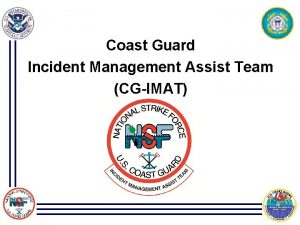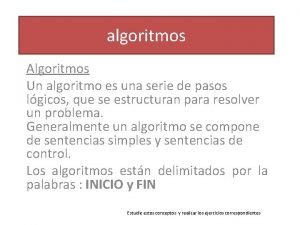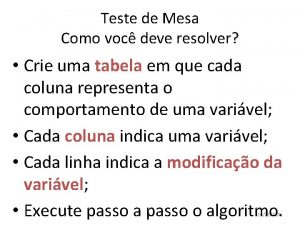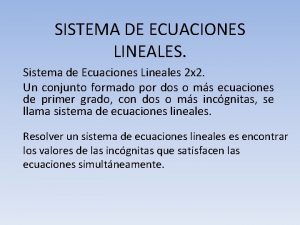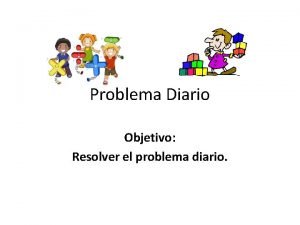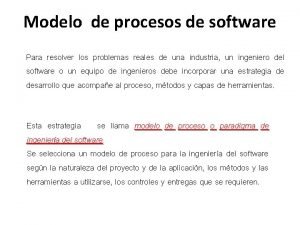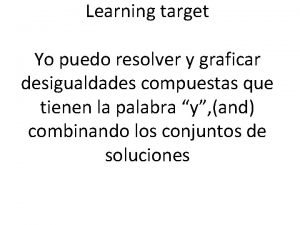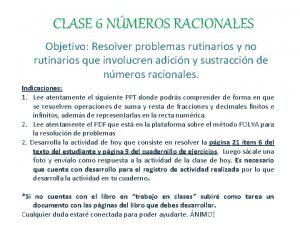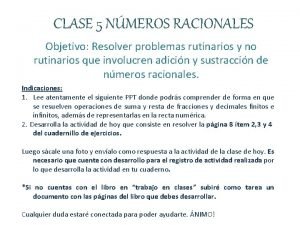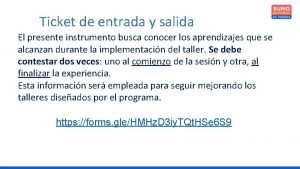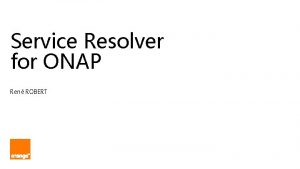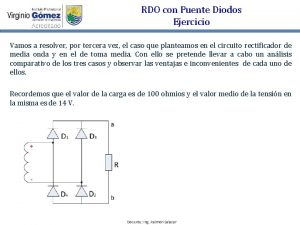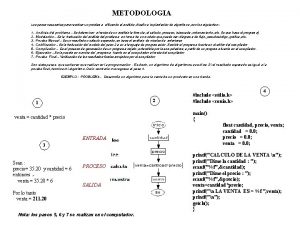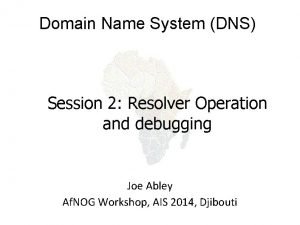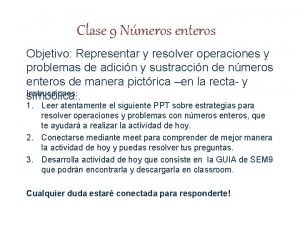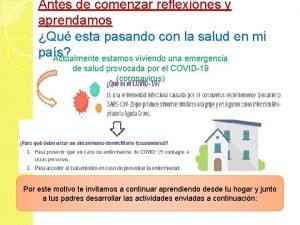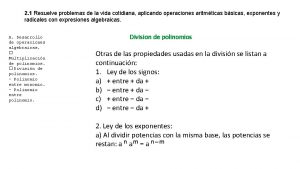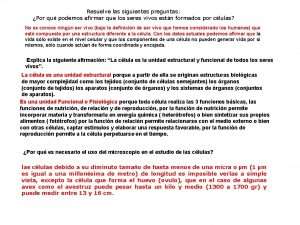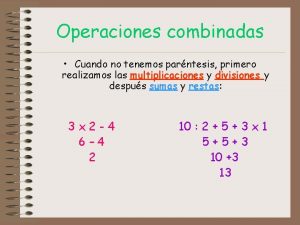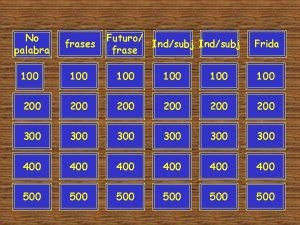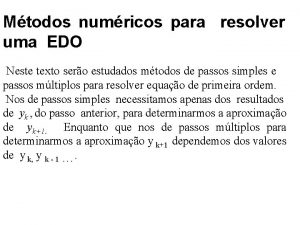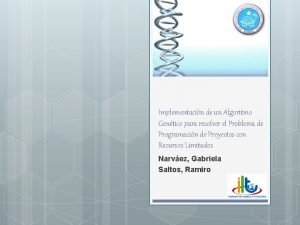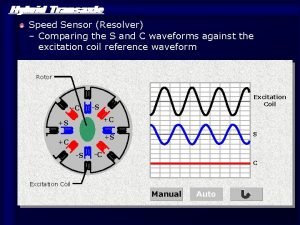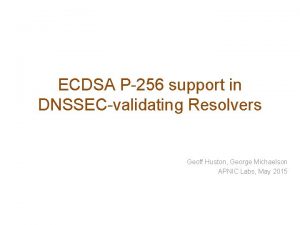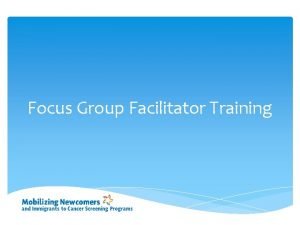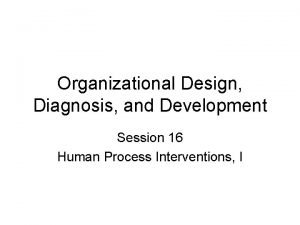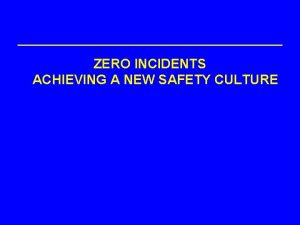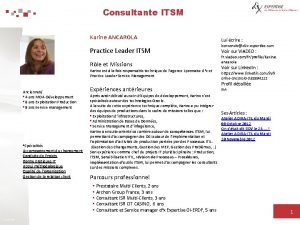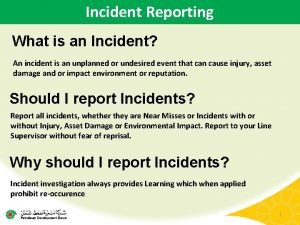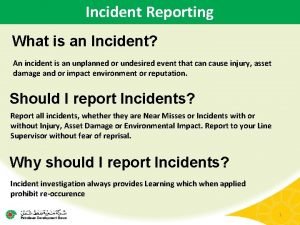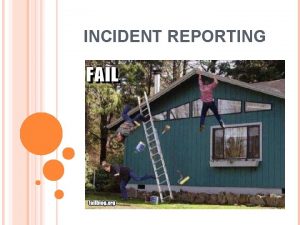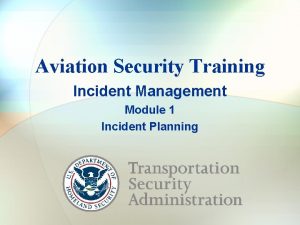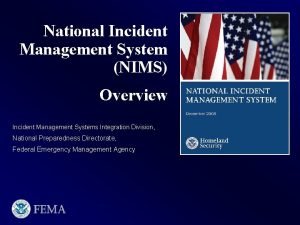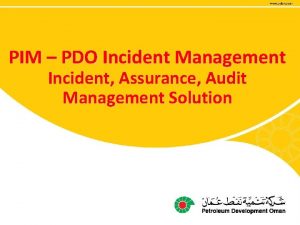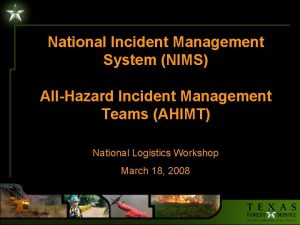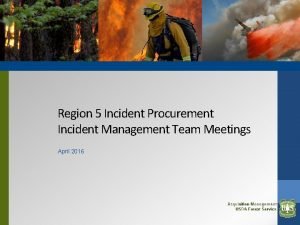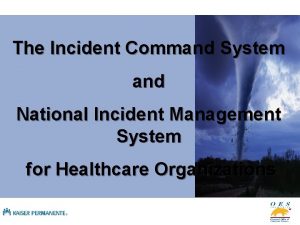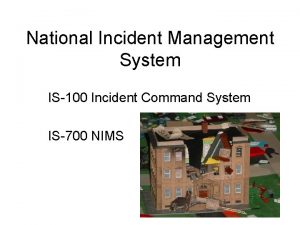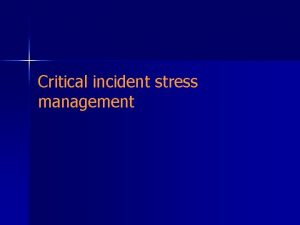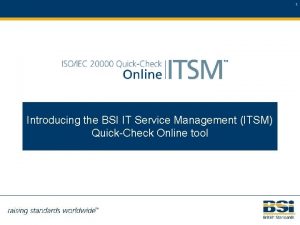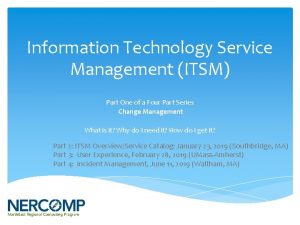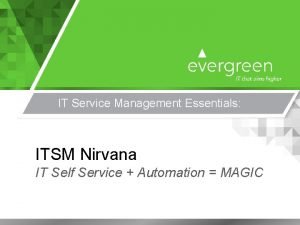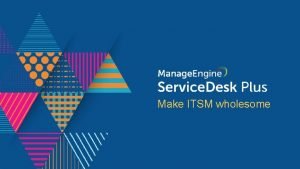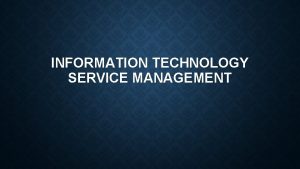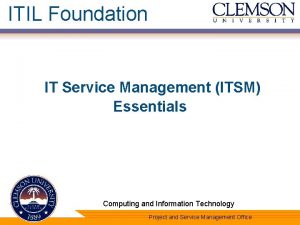Incident Management Training Resolver Group ITSM 7 6
























































































































- Slides: 120

Incident Management Training Resolver Group ITSM 7. 6. 04 GITOS

Objectives Upon completion of this course, the participant will be able to: • Understand the main features of the Incident Management Console • Describe the procedure to modify and search for Incident tickets • Describe the procedure to resolve Incident tickets For Training Purposes Only. Printed versions of this document may not be current.

Agenda • Introduction • Searching for Incidents • The Incident Management console • Frequently Asked Questions • Working with Incidents • Reviewing an Incident • Specifying Relationships • Accessing On-line Help • The In Progress process • Updating an Incident • The Re-Assignment process • Resolving an Incident For Training Purposes Only. Printed versions of this document may not be current.

Introduction Incident Management - Resolver Training ITSM 7. 6. 04

Overview - Introduction In this section we will look at: • The Incident Management Process • Opening the ITSM tool • The IT Home Page For Training Purposes Only. Printed versions of this document may not be current.

The Incident Management Process • The Service Desk provides Level 1 user support and is responsible for creating and working on Incidents in ITSM • Resolvers function as the Level 2 and/or Level 3 Support Staff and are responsible for resolving Incidents assigned to their group by the Level 1 Service Desk For Training Purposes Only. Printed versions of this document may not be current.

The Incident Management Process • As an efficient Resolver you will: • Locate and work on Incident tickets that have been assigned to your team (Work Group) • Manage the Incidents list of your Resolver Group • Resolve or re-assign Incidents as required to meet resolution expectations for Service Level Agreements For Training Purposes Only. Printed versions of this document may not be current.

The Incident Management Process • Upon Receiving a Notification mail for new Incidents that have been assigned to your group: Login to the ITSM tool with your credentials • On the next slides we will look at - How to open the application - What you can find on the Home Page of the tool after logging on For Training Purposes Only. Printed versions of this document may not be current.

Opening the ITSM tool • Below you can see the logon screen of the ITSM 7. 6. 04 tool For Training Purposes Only. Printed versions of this document may not be current.

The IT Home Page • After logging on to ITSM, the IT Home Page is displayed: For Training Purposes Only. Printed versions of this document may not be current.

The IT Home Page Features of the IT Home Page: • The Home Page allows you to control the information that is displayed on the Home Page - You can add 4 live-content panels to the Home Page • Collapsible Applications Menu allows you to quickly access different functionalities and consoles of ITSM - You can save time when opening a console, as the Applications Menu is accessible from all consoles • Each console opens in the same browser window (tab) - To open a console in a new browser window you can alternatively use: Shift + Click For Training Purposes Only. Printed versions of this document may not be current.

The IT Home Page Links for Home, Forward and Backward Navigation Collapsible Applications Menu to access the available consoles in ITSM Customizable Live Content Panels For Training Purposes Only. Printed versions of this document may not be current.

The IT Home Page ü How to customize which panels appear on the IT Home Page? 1. Click on the Add content to layout button in the top right corner of the screen For Training Purposes Only. Printed versions of this document may not be current.

The IT Home Page 2. Open the dropdown menu in the Show field to select what option you would like to view in each panel For Training Purposes Only. Printed versions of this document may not be current.

The IT Home Page 3. You can remove any unnecessary panels by using the Close button in the top right corner of the panel For Training Purposes Only. Printed versions of this document may not be current. Page 15

The IT Home Page 4. Once you are finished with customizing the Home Page view, click on the Save Current Layout button • This way you will see the same view the next time you visit the Home Page For Training Purposes Only. Printed versions of this document may not be current.

Review - Introduction In this section we have looked at: • The Incident Management Process • Opening the ITSM tool • The IT Home Page For Training Purposes Only. Printed versions of this document may not be current.

The Incident Management console Incident Management - Resolver Training ITSM 7. 6. 04

Overview – The Incident Mgmt console In this section we will look at: • How to access the Incident Management console • Parts of the Incident Mgmt console window • Using the Navigation buttons • The Counts section and the Incidents list • The Show and Filter By options • The Quick Actions option For Training Purposes Only. Printed versions of this document may not be current.

How to access the Incident Mgmt console • The Incident Management console is accessible from the IT Home Page 1. Open the Applications Menu 2. Select the IM Console or on the left handside the New Incident form For Training Purposes Only. Printed versions of this document may not be current.

Parts of the Incident Mgmt console window Links for Home, Forward & Backward Navigation and Recent List The View Broadcasts button displays the current broadcast messages The Counts section shows the number of Incidents for various categories For Training Purposes Only. Printed versions of this document may not be current.

Using the Navigation buttons • The usage of the Home, Forward & Backward Navigation and the Recent List buttons help you navigate easily through the ITSM tool The Backward button brings you back to the window you visited previously The Forward button brings you back to the window you were viewing before using the Backward button The Recent List button allows you to see the list of tickets you were working on recently For Training Purposes Only. Printed versions of this document may not be current. The Home button brings you back to the IT Home Page

The Counts section and the Incidents list • The Counts section displays real-time statistics and provides direct access to customizable Incident lists You can see up-to-date ticket statistics in the Counts section When you click on any of the available buttons in the Counts section, the Incident list updates the displayed tickets accordingly For Training Purposes Only. Printed versions of this document may not be current.

The Counts section and the Incidents list • The statistics displayed in the Counts section can be customized by using the Show and Filter By filtering options When you change the values in the Show and Filter By fields, the statistics displayed in the Counts section and the Incidents list are updated immediately For Training Purposes Only. Printed versions of this document may not be current.

The Show and Filter By options • The Show and Filter By options appear on the top of the Incidents list • These options allow you to perform quick searches • The results of your searches will be displayed to you directly in the Incidents list • These are the available options in the Show drop-down list: For Training Purposes Only. Printed versions of this document may not be current.

The Show and Filter By options • Below you can see the available options in the Filter By field: For Training Purposes Only. Printed versions of this document may not be current.

The Show and Filter By options • You can also use the More Filters option to specify further filtering options for the Incidents list For Training Purposes Only. Printed versions of this document may not be current.

The Quick Actions option • You can quickly perform various actions by using the Quick Actions menu, without having to open the Incident itself • “Assign to Group Member” allows you to specify one of the members of your Assignment Group as the Assignee of the Incident • “Assign to Me” allows you to quickly assign the Incident to yourself • “Incident Closure” allows you to move a Resolved Incident in the Closure phase For Training Purposes Only. Printed versions of this document may not be current.

Review – The Incident Mgmt console In this section we have looked at: • How to access the Incident Management console • Parts of the Incident Mgmt console window • Using the Navigation buttons • The Counts section and the Incidents list • The Show and Filter By options • The Quick Actions option For Training Purposes Only. Printed versions of this document may not be current.

Working with Incidents ITSM 7. 6. 04 Upgrade Awareness Training

Reviewing an Incident • In this section we will look at how you can work with Incident tickets during your everyday work • The current section will cover the full lifecycle of the ticket handling process, including: • Reviewing an Incident • The In Progress process • Updating an Incident • The Re-Assignment process • Resolving an Incident For Training Purposes Only. Printed versions of this document may not be current.

Working with Incidents - Reviewing an Incident ITSM 7. 6. 04 Upgrade Awareness Training

Reviewing an Incident In this section we will look at: • Where you can find useful information in Incident tickets • Which fields are necessary to be reviewed before starting to work on an Incident • What is the meaning of the fields you can find in an Incident For Training Purposes Only. Printed versions of this document may not be current.

Reviewing an Incident • All Resolvers working on Incident tickets are expected to review the following fields when starting to work on an Incident: • Customer & Contact details • Assigned Group • Notes & Summary • Resolution details • Impact, Urgency, Priority • Relationships • Status • Categorizations • Work Info History For Training Purposes Only. Printed versions of this document may not be current.

Reviewing an Incident Review Expectations • Customer & Contact details: The Customer field contains information about the affected user. The Contact field contains information about the secondary contact for this issue. • Notes & Summary: To be informed about the original worklog provided in the Incident • Impact, Urgency and Priority: To understand the current state of the Incident • Status & Status Reason: The Incidents location in the Incident Lifecycle • Work Info History: To see all investigation and diagnosis, workaround, escalation, communication and resolution activities that have been performed so far For Training Purposes Only. Printed versions of this document may not be current.

Reviewing an Incident Review Expectations • Resolution details: This field is populated only once the issue has been resolved, and contains information about the solution that resolved the issue • Assigned Group: To see which group is supposed to take the next action on the ticket • Relationships: To identify all relationships to other tickets • Categorizations: To see the Operation and Product Categorization of the ticket • On the next slide we will take a look at where you can find these fields in the Incident ticket window For Training Purposes Only. Printed versions of this document may not be current.

Reviewing an Incident Customer & Contact details Relationships Notes & Summary Work Info History Impact, Urgency, Priority Status Assigned Group Resolution details For Training Purposes Only. Printed versions of this document may not be current.

Reviewing an Incident • Now we will look at further details about the fields that are necessary to be reviewed when working with Incidents • This will help you to understand the information displayed in the fields of the Incident tickets For Training Purposes Only. Printed versions of this document may not be current.

Reviewing an Incident Customer & Contact details • The Customer field contains the name of the user who is affected - This field will always contain the name of a user • The Contact field can be used to indicate a 2 nd contact person for the ticket - This field will only contain the name of a user if there was a 2 nd contact person For Training Purposes Only. Printed versions of this document may not be current.

Reviewing an Incident Customer & Contact details • When clicking on the arrows in the top-right corner, you’ll see the Phone number and the Site of the Customer and/or the Contact For Training Purposes Only. Printed versions of this document may not be current.

Reviewing an Incident Customer & Contact details • Below you can find information about the functionality of the buttons next to the Customer and Contact fields Customer Search: this button allows you to search for a customer in the system View Contact details: this button allows you to view all the details of the current Customer / Contact (including Corporate ID and Department) Clear Contact : this button would clear the currently selected user from this ticket For Training Purposes Only. Printed versions of this document may not be current.

Reviewing an Incident Customer & Contact details • You can also temporarily change the Phone number and/or the Site of the Customer and/or the Contact if necessary • This will only affect the ticket that you are working on currently • On the next slide we will look at the steps you’d need to perform in order to be able to change the Phone number or the Site of the user For Training Purposes Only. Printed versions of this document may not be current.

Reviewing an Incident Customer & Contact details • Follow the below steps to change the Phone number or the Site temporarily in a ticket: 1. Click on the arrows in the top-right corner 2. Click on the Edit button next to the field you would like to modify For Training Purposes Only. Printed versions of this document may not be current.

Reviewing an Incident Notes & Summary • The Summary field contains a brief summary of the issue • The Notes field contains the initial work information from the group that created the ticket • To look at the full details of the Notes section: click on the button next to the Notes field For Training Purposes Only. Printed versions of this document may not be current.

Reviewing an Incident Impact, Urgency & Priority • These fields provide information about the business criticality of the issue that is described in the ticket • These fields will already be populated once the ticket is assigned to a Resolver Group (the creator of the ticket will provide this information) • The combination of the Impact and the Urgency form the Priority of each ticket • On the next slides we will review the meaning of the Impact, Urgency and Priority codes For Training Purposes Only. Printed versions of this document may not be current.

Reviewing an Incident Impact, Urgency & Priority • Impact: Provides an indication of the problem's impact on the user community • Urgency: Provides an indication of how urgent the problem resolution is to the requester • Priority: This field is automatically set to the appropriate option based on the combination of the Impact and Urgency field values For Training Purposes Only. Printed versions of this document may not be current.

Reviewing an Incident Impact, Urgency & Priority Impact levels: • 1 -Extensive/Widespread Service down for more than one user • 2 -Significant/Large Service degraded for more than one user • 3 -Moderate/Limited Service down for one user • 4 -Minor/Localized No degradation of service or service degraded for one user For Training Purposes Only. Printed versions of this document may not be current.

Reviewing an Incident Impact, Urgency & Priority Urgency levels 1 -Critical • No Work Around in place • Large number of related Incidents 2 -High • Issue affects a business critical service • Large number of related Incidents • Risk of Recurrence or additional Service Impact High • Large Number of users / sites affected 3 -Medium • Work Around in place, but not optimal • Low number of related Incidents • Risk of Recurrence or additional Service Impact Minimal 4 -Low • Work Around in place • No Related Incidents • Risk of Recurrence or additional Service Impact Low For Training Purposes Only. Printed versions of this document may not be current.

Reviewing an Incident Impact, Urgency & Priority The Priority levels are selected automatically based on Impact + Urgency: Standard Priority Levels 1 -Critical Mission critical business function or entity down 2 -High: Critical application problem 3 -Medium Non-critical application problem 4 -Low Non-critical, non-business impacting issue For Training Purposes Only. Printed versions of this document may not be current.

Reviewing an Incident Impact, Urgency & Priority This table shows how the Priority level is defined based on the Impact and the Urgency codes that were selected by the Incident creator. Impact Urgency Critical High Medium Low 1 -Extensive/Widespread Critical High Low 2 -Significant/Large Critical High Medium Low 3 -Moderate/Limited High Medium Low 4 -Minor/localized High Medium Low For Training Purposes Only. Printed versions of this document may not be current. Page 50

Reviewing an Incident Status & Status Reason • Below you can see the available Status codes of Incident tickets in ITSM: • New • Assigned • In Progress • Pending • Resolved • Closed • Cancelled For Training Purposes Only. Printed versions of this document may not be current.

Reviewing an Incident Status & Status Reason ITSM Incident Status codes and their explanations New Description Assigned The responsibility for the resolution of the incident request has been assigned to a specific group or group member. In Progress The incident request is currently being resolved. Pending It is temporarily not possible to make any further progress in the resolution of the incident request. The reason for this is specified in the Status Reason field. Resolved The work on the resolution of the incident request has come to an end because of the reason specified in the Status Reason field. Closed The incident request has been closed because the customer has accepted the solution, or because of the reason specified in the Status Reason field. Cancelled The incident request has been cancelled because the customer has withdrawn the request. The incident request has not yet been saved For Training Purposes Only. Printed versions of this document may not be current.

Reviewing an Incident Status & Status Reason • Status Reason codes are only required when using one of the following 3 Status codes: – Pending – Resolved – Closed • The Status Reason codes are available from the dropdown menu according to the Status that was selected • On the next slides we will take a look at the available Status Reason codes and their explanations For Training Purposes Only. Printed versions of this document may not be current.

Reviewing an Incident Status & Status Reason Available Status Reason codes for the Pending Status Automated Resolution Reported Client Hold The Client has asked for the Incident to be placed on Hold. Client Action Required Action by the client is required to continue with the request. Support Contact Hold Local Site Action Required Action by someone at the local site is required to continue with the request. Purchase Order Approval required to continue with the request. Registration Approval required to continue with the request. Supplier Delivery of equipment is required to continue with the request. Third Party Vendor Action Required is required to continue Required with the request. Infrastructure Change Request A request has been placed. Onsite SR has been submitted Monitoring Incident The Incident is being monitored. Future Enhancement required to continue with the request. For Training Purposes Only. Printed versions of this document may not be current.

Reviewing an Incident Status & Status Reason Available Status Reason codes for the Resolved Status Automated Resolution Reported Customer Follow-Up Required The Incident has been resolved; and is awaiting the Customer Follow-Up Activities. Temporary Corrective Action Future Enhancement The Incident has been resolved with Temporary Corrective Action The Incident has been moved to a resolved status with the understanding that a future enhancement is required. The Incident has been moved to a resolved status; and the Technical support is monitoring the Incident. The Incident has been resolved and does not require further action. An onsite SR has resolved the issue Monitoring Incident No Further Action Required Onsite SR For Training Purposes Only. Printed versions of this document may not be current.

Reviewing an Incident Status & Status Reason Available Status Reason codes for the Closed Status SD First Call Resolution SD performed First Call Resolution Customer Support Group A Customer Support Group has been assigned to resolve the Incident SD Remote Assistance Onsite SR Automated Resolution Reported The Incident was resolved by SD Remote Assistance An Onsite SR has resolved the Issue. Automated Resolution Reported Support Group A Support Group has resolved the Incident. Vendor SD Resolution Infrastructure Change Created A Vendor has resolved the Incident. A SD Agent has resolved the Incident. Infrastructure Change Created to resolve the Incident. For Training Purposes Only. Printed versions of this document may not be current.

Reviewing an Incident Work Info History • Look at the default Work Detail tab of the Incident to see information about work that has been done previously on the current ticket For Training Purposes Only. Printed versions of this document may not be current.

Reviewing an Incident Work Info History • You can also use the buttons above the Work Info Entry list for further functionalities related to the Work Info Add new Work Info Edit selected Work Info View and print Work Info History View Work Info History For Training Purposes Only. Printed versions of this document may not be current.

Reviewing an Incident Assigned Group • Review this field in order to see which group is supposed to take the next action on the ticket For Training Purposes Only. Printed versions of this document may not be current.

Reviewing an Incident Resolution details • This field will only contain information if the issue has been resolved already • The Resolution field is used for providing a description of the solution For Training Purposes Only. Printed versions of this document may not be current.

Reviewing an Incident Relationships • When opening the Relationships tab, you’ll see if there is a relationship between the current ticket and another ticket • These Relationships can be specified manually • We will look at how you can specify Relationships at the end of this training For Training Purposes Only. Printed versions of this document may not be current.

Reviewing an Incident Categorizations • The Categorization information can be opened from the navigation menu on the left handside • To view the Incident Categorization: 1. Open the Links menu 2. Click on Categorizations For Training Purposes Only. Printed versions of this document may not be current.

Reviewing an Incident Categorizations • The Categorizations of an Incident ticket is divided into 4 main sections Operational Categorization Resolution Operational Categorization Product Categorization Resolution Product Categorization For Training Purposes Only. Printed versions of this document may not be current.

Reviewing an Incident Categorizations • The Operational and Product Categorizations will alreday be populated once you receive the Incident • The Resolution Categorizations will be populated when Resolving the Incident ticket For Training Purposes Only. Printed versions of this document may not be current.

Categorization guidelines Categorizations • Operational Categorization Guidelines Tier 1 Description of what happened to the product or service. Example: Failure, Error Message Tier 2 High Level component that is being affected. Tier 3 Specific component that is being affected. For Training Purposes Only. Printed versions of this document may not be current.

Categorization guidelines Categorizations • Product Categorization Guidelines Tier 1 Description High Level Organization of Products and Services. Example: Infrastructure = Server, Database, network Tier 2 Mid level break down of products and services Tier 3 Product or service that is being affected Example: Email Product Name of the Product or Service. Example: Outlook or Lotus Notes Model/Version Specific Version of the Product Name. Example: Outlook 2000 Manufacture of the Product or service. Example: Microsoft For Training Purposes Only. Printed versions of this document may not be current.

Reviewing an Incident In this section we have looked at: • Where you can find useful information in Incident tickets • Which fields are necessary to be reviewed before starting to work on an Incident • What is the meaning of the fields you can find in Incidents For Training Purposes Only. Printed versions of this document may not be current.

Working with Incidents - The In Progress process ITSM 7. 6. 04 Upgrade Awareness Training

The In Progress process In this section we will look at: • What steps to perform after reviewing an Incident • How to indicate that you have started to work on a specific Incident For Training Purposes Only. Printed versions of this document may not be current.

The In Progress process • The Work in Progress process begins after reviewing the details of an Incident ticket • With this step you accept / acknowledge working on a specific ticket • On the next slide you’ll see a step-by-step guide about how you can perform these steps in ITSM 7. 6. 04 For Training Purposes Only. Printed versions of this document may not be current.

The In Progress process 1. Change the ticket status to In Progress 2. Select your name in the Assignee+ field using the drop-down list 3. Add a Work Info note to the ticket • Put your notes in the Notes field • Click on Add 4. Click on Save For Training Purposes Only. Printed versions of this document may not be current.

The In Progress process In this section we have looked at: • What steps to perform after reviewing an Incident • How to indicate that you have started to work on a specific Incident For Training Purposes Only. Printed versions of this document may not be current.

Working with Incidents - Updating an Incident ITSM 7. 6. 04 Upgrade Awareness Training

Updating an Incident In this section we will look at: • What steps you need to perform whenever you’ve been working on an Incident ticket • How to specify further details of Work Info entries For Training Purposes Only. Printed versions of this document may not be current.

Updating an Incident • On the previous slides we have already seen how you can quickly add a simple Work Info to a ticket • Now we will look at further options you can specify for your Work Info, such as: • Adding multiple attachments • Specifying Work Info Type • Locking your Work Info entry • Specifying View Access (Public or Internal) For Training Purposes Only. Printed versions of this document may not be current.

Updating an Incident This is the Work Info area without the additional editing options: This is what you will see after clicking on the More Details button in the Work Info area For Training Purposes Only. Printed versions of this document may not be current.

Updating an Incident • You can add up to 3 attachments to each Work Info entry • The maximum file size for attachments is 5 MB • You can create locked or unlocked Work Info logs • You can specify the View Access as Internal or Public For Training Purposes Only. Printed versions of this document may not be current.

Updating an Incident In this section we have looked at: • What steps you need to perform whenever you’ve been working on an Incident ticket • How to specify further details of Work Info entries For Training Purposes Only. Printed versions of this document may not be current.

Working with Incidents - The Re-Assignment process ITSM 7. 6. 04 Upgrade Awareness Training

The Re-Assignment process In this section we will look at: • What to do in case an Incident ticket has to be assigned to another Assigned Group - This might have several different reasons, such as: § Another resolver group has to perform some work related to the resolution of the issue § Another resolver group is responsible for this issue § The ticket does not contain sufficient information in order to be resolved and has to be assigned back to the Service Desk § The ticket was incorrectly assigned to the wrong resolver group and has to be assigned back to the Service Desk for further actions For Training Purposes Only. Printed versions of this document may not be current.

The Re-Assignment process • The following steps are performed in case of re-assigning an Incident to any other Assigned Group 1. Change the ticket Status to: Assigned 2. Select the appropriate Assigned Group using the drop-down menu 3. Provide a Work Info with a description of the issue • On the next slide we will take a look at how you can perform these steps in ITSM 7. 6. 04, including screenshots For Training Purposes Only. Printed versions of this document may not be current.

The Re-Assignment process 1. Change the ticket Status to: Assigned 2. Select the appropriate Assigned Group using the drop-down menu 3. Provide a Work Info with a description of the issue 4. Click on Save For Training Purposes Only. Printed versions of this document may not be current.

The Re-Assignment process In this section we have looked at: • What to do in case an Incident ticket has to be assigned to another Assigned Group For Training Purposes Only. Printed versions of this document may not be current.

Working with Incidents - Resolving an Incident ITSM 7. 6. 04 Upgrade Awareness Training

Resolving an Incident In this section we will look at: • What steps to perform in case the issue that was described in the ticket has already been resolved For Training Purposes Only. Printed versions of this document may not be current.

Resolving an Incident Follow the below steps in order to Resolve an Incident: 1. Change the Incident Status to: Resolved 2. Specify the Status Reason Code 3. Provide information about the solution in the Resolution field For Training Purposes Only. Printed versions of this document may not be current.

Resolving an Incident 4. Click on the Links menu and open the Categorizations window 5. Fill in the Resolution Categorization, click on Save 6. Click on Save again to save the Incident For Training Purposes Only. Printed versions of this document may not be current.

Resolving an Incident • We will now review the steps that are required to resolve an Incident: 1. Change the Incident Status to: Resolved 2. Specify the Status Reason Code 3. Provide information about the solution in the Resolution field 4. Click on the Links menu and open the Categorizations window 5. Fill in the Resolution Categorization, click on Save 6. Click on Save again to save the Incident For Training Purposes Only. Printed versions of this document may not be current.

Resolving an Incident In this section have looked at: • What steps to perform in case the issue that was described in the ticket has already been resolved For Training Purposes Only. Printed versions of this document may not be current.

Review - Working with Incidents • In this section we have looked at how you can work with Incident tickets during your everyday work • The current section covered the full lifecycle of the ticket handling process, including: • Reviewing an Incident • The In Progress process • Updating an Incident • The Re-Assignment process • Resolving an Incident For Training Purposes Only. Printed versions of this document may not be current.

Searching for Incidents in ITSM 7. 6. 04 Upgrade Awareness Training

Overview In this section we will look at: • The most important ways of searching for Incidents in ITSM 7. 6. 04, including: 1. The Incident List searches 2. The Search Incident form 3. The Keyword based search within Incidents For Training Purposes Only. Printed versions of this document may not be current.

The Incident List searches • The following options and settings are available when using the Incident List as a basis of your Incident searches: • Default view and Application Preferences settings • Show and Filter By options • More Filters option • Quick Actions options • Add to Watch List option For Training Purposes Only. Printed versions of this document may not be current.

The Incident List searches Default view and Application Preferences settings • In the Incidents list you will see by default all Incidents that are assigned to you personally • You can adjust the default view of this list permanently by changing your Application Preferences settings For Training Purposes Only. Printed versions of this document may not be current.

The Incident List searches Default view and Application Preferences settings • To change your Application Preferences settings, go to: 1. Functions menu 2. Application Preferences For Training Purposes Only. Printed versions of this document may not be current.

The Incident List searches Default view and Application Preferences settings • You can then adjust your default Incident List view settings in the Application Preferences window For Training Purposes Only. Printed versions of this document may not be current.

The Incident List searches Show and Filter By options • You can temporarily change the search criteria of the Incident List by adjusting the selections in the Show and Filter By fields For Training Purposes Only. Printed versions of this document may not be current.

The Incident List searches More Filters option • You can use additional filtering options by clicking on the More Filters options next to the Filter By field • This will also automatically update the results displayed in the Incident List window For Training Purposes Only. Printed versions of this document may not be current.

The Incident List searches Quick Actions options • You can perform various actions by using the Quick Actions menu above the Incident List, without having to open the Incident itself • „Assign to Group Member” allows you to specify one of the members of your Assignment Group as the Assignee of the Incident • „Assign to Me” allows you to quickly assign the Incident to yourself • „Incident Closure” allows you to move a Resolved Incident in the Closure phase For Training Purposes Only. Printed versions of this document may not be current.

The Incident List searches Add to Watch List option • You can add any Incidents from the Incident List to a so called Watch List • The Watch List helps you to keep an eye on critical or urgent tickets • Your Watch List can be accessed any time from the IM console • Your own Watch List is only visible to you personally For Training Purposes Only. Printed versions of this document may not be current.

The Incident List searches Add to Watch List option • To add a specific Incident to your Watch List: 1. Highlight the ticket in your Incident List 2. Click on the Add to Watch List button For Training Purposes Only. Printed versions of this document may not be current.

The Incident List searches Add to Watch List option • To view your Watch List: 1. Open the Incident Management Console 2. Select the Watch List option in the Show filtering field For Training Purposes Only. Printed versions of this document may not be current.

The Search Incident form • You can also use the Search Incident form to perform Incident Searches • When using the Search Incident form, you will see an empty Incident ticket window which you can use to specify your search criteria • You can extend the functionalities of the Search Incident form by using the Advanced Search or the Saved Searches options For Training Purposes Only. Printed versions of this document may not be current.

The Search Incident form in ITSM 7. 6. 04: For Training Purposes Only. Printed versions of this document may not be current.

The Search Incident form • The Advanced Search option and the Searches button to save your searches can be found on the top of the Search Incident form • The Advanced Search option allows you to specify additional search criteria using the qualification builder feature • The Searches option allows you to save your search criteria for later use For Training Purposes Only. Printed versions of this document may not be current.

The Keyword based search within Incidents • By pressing F 3 on your keyboard when viewing an Incident, you can search for specific keywords within the ticket you are viewing at the moment • ITSM will highlight the specified word in the Incident window For Training Purposes Only. Printed versions of this document may not be current.

Overview In this section we have looked at: • The most important ways of searching for Incidents in ITSM 7. 6. 04, including: 1. The Incident List searches 2. The Search Incident form 3. The Keyword based search within Incidents For Training Purposes Only. Printed versions of this document may not be current.

Frequently Asked Questions ITSM 7. 6. 04 Upgrade Awareness Training

Frequently Asked Questions In this section we will look at: • Specifying Relationships • Accessing Online Help For Training Purposes Only. Printed versions of this document may not be current.

Frequently Asked Questions Specifying Relationships in ITSM 7. 6. 04 • To specify a Relationship between 2 existing tickets in ITSM 7. 6. 04, the following steps can be performed: 1. Click on the Create Relationship to option, and specify the ticket type (Incident) For Training Purposes Only. Printed versions of this document may not be current.

Frequently Asked Questions Specifying Relationships in ITSM 7. 6. 04 2. In the Incident Relationship Search window, perform a search for the ticket you would like to relate your current ticket to Tip: • Enter your Search criteria (E. g. : Incident ID, Status or Assigned Group, etc. ) • Click on Search For Training Purposes Only. Printed versions of this document may not be current.

Frequently Asked Questions Specifying Relationships in ITSM 7. 6. 04 3. Once the required ticket was found, highlight it and specify the Relationship Type 4. Click on the Relate button For Training Purposes Only. Printed versions of this document may not be current.

Frequently Asked Questions Specifying Relationships in ITSM 7. 6. 04 • The Relationship will now be visible on the Relationships tab of the Incident For Training Purposes Only. Printed versions of this document may not be current.

Frequently Asked Questions Accessing Online Help • Any time you need assistance with the ITSM tool, the Help link in the upper-right corner of the ITSM window can be opened For Training Purposes Only. Printed versions of this document may not be current.

Frequently Asked Questions • The On-Line Help window will open allowing the user to select the appropriate ITSM console • Double-click or highlight the console you require help with and click on OK For Training Purposes Only. Printed versions of this document may not be current.

Frequently Asked Questions • The On-Line Help window will open and the menu will allow the user to browse through the topics related to out of the box ITSM functions • NOTE: This function does not provide process-specific information For Training Purposes Only. Printed versions of this document may not be current.

Frequently Asked Questions In this section we have looked at: • Specifying Relationships • Accessing On-Line Help For Training Purposes Only. Printed versions of this document may not be current.

Review and Summary Incident Management - Resolver Training ITSM 7. 6. 04

Review - Agenda • Introduction • Searching for Incidents • The Incident Management console • Frequently Asked Questions • Working with Incidents • Specifying Relationships • Accessing On-line Help • Reviewing an Incident • The In Progress process • Updating an Incident • The Re-Assignment process • Resolving an Incident For Training Purposes Only. Printed versions of this document may not be current.

Review - Objectives You should now be able to: • Understand the main features of the Incident Management Console • Describe the procedure to modify and search for Incident tickets • Describe the procedure to resolve Incident tickets For Training Purposes Only. Printed versions of this document may not be current.
 Itsm7
Itsm7 Incident objectives that drive incident operations
Incident objectives that drive incident operations Itsm migration
Itsm migration Maximo integration services
Maximo integration services Higher ed itsm
Higher ed itsm Itsm terms and terminologies
Itsm terms and terminologies Itsm and ppm
Itsm and ppm Itsm mission statement
Itsm mission statement Gartner design thinking lean startup agile
Gartner design thinking lean startup agile Smm service scope of work
Smm service scope of work Gap analysis of incident management process
Gap analysis of incident management process Traffic incident management test answers
Traffic incident management test answers Maximo health safety and environment manager
Maximo health safety and environment manager Splunk incident management
Splunk incident management Incident en probleemmanagement
Incident en probleemmanagement Ims incident management
Ims incident management Incident response technologies
Incident response technologies Sit report
Sit report Swarming incident management
Swarming incident management Incident response workflow
Incident response workflow Servicenow problem management
Servicenow problem management Heat incident management
Heat incident management Agile incident management
Agile incident management Incident management coordinator
Incident management coordinator Dlp remediation
Dlp remediation Safety incident management system
Safety incident management system Interagency incident business management handbook
Interagency incident business management handbook Ics 400: advanced ics for complex incidents-aberdeen
Ics 400: advanced ics for complex incidents-aberdeen Incident resource management process
Incident resource management process Zoho it asset management
Zoho it asset management Incident management assistance team
Incident management assistance team Las siguientes problemas
Las siguientes problemas Resolver las siguientes preguntas
Resolver las siguientes preguntas Ejercicios de ecuaciones de primer grado
Ejercicios de ecuaciones de primer grado Lisp map resolver
Lisp map resolver Reglas de inecuaciones con valor absoluto
Reglas de inecuaciones con valor absoluto Como resolver una prueba de habilidades y destrezas de aon
Como resolver una prueba de habilidades y destrezas de aon Equações literais do 1 grau exercícios doc
Equações literais do 1 grau exercícios doc Ejemplos de colectividad
Ejemplos de colectividad Resolver algoritmos
Resolver algoritmos Alma link resolver
Alma link resolver Regla de ruffini ejemplos
Regla de ruffini ejemplos Chemical identifier resolver
Chemical identifier resolver Resolver
Resolver Resolver inecuaciones fraccionarias
Resolver inecuaciones fraccionarias Resolver los siguientes ejercicios
Resolver los siguientes ejercicios Trasduttore di inclinazione
Trasduttore di inclinazione Teste de mesa
Teste de mesa Resolver gráficamente el siguiente sistema de ecuaciones:
Resolver gráficamente el siguiente sistema de ecuaciones: Concepto de ecuacion de segundo grado
Concepto de ecuacion de segundo grado Diario objetivo
Diario objetivo Objetivos para resolver problemas
Objetivos para resolver problemas Adicin
Adicin Modelo de espiral
Modelo de espiral Coeficiente indeterminado
Coeficiente indeterminado Grafique
Grafique Resolver
Resolver Como resolver
Como resolver Profa kempis multiplicaciones con número decimal
Profa kempis multiplicaciones con número decimal Problemas rutinarios y no rutinarios
Problemas rutinarios y no rutinarios Como pasar numero periodico a fraccion
Como pasar numero periodico a fraccion Resuelve las siguientes divisiones
Resuelve las siguientes divisiones Resolver
Resolver Resolver
Resolver Tablas de multiplicar para resolver
Tablas de multiplicar para resolver Resolver
Resolver Lee las siguientes preguntas y contestarlas en tu cuaderno
Lee las siguientes preguntas y contestarlas en tu cuaderno Resolver problema
Resolver problema Resuelve las siguientes situaciones
Resuelve las siguientes situaciones Resolver
Resolver Livre caminho médio
Livre caminho médio Contração
Contração Camila tiene 96 libros ordenados en dos estanterias
Camila tiene 96 libros ordenados en dos estanterias Resolver
Resolver Exponentes y logaritmos
Exponentes y logaritmos Resolver
Resolver Resolver problemas matemáticos
Resolver problemas matemáticos Cuando dices no puedo
Cuando dices no puedo Resolver
Resolver Resolver
Resolver Como resolver
Como resolver Resolver las siguientes multiplicaciones
Resolver las siguientes multiplicaciones Resolver p
Resolver p Movimiento lineal formula
Movimiento lineal formula Resuelve las siguientes preguntas en tu cuaderno
Resuelve las siguientes preguntas en tu cuaderno Resolver
Resolver Resolver
Resolver Parntesis
Parntesis El calentamiento global sigue avanzando sin que nadie
El calentamiento global sigue avanzando sin que nadie Edo
Edo Frases de ecuaciones
Frases de ecuaciones Ion ipa145
Ion ipa145 Resolver
Resolver Resolver speed sensor
Resolver speed sensor Exponenciais
Exponenciais Como resolver
Como resolver Problemas matemticos
Problemas matemticos Resolver
Resolver Equação de 1 grau com parenteses
Equação de 1 grau com parenteses Group polarization psychology definition
Group polarization psychology definition Within group variance vs between group
Within group variance vs between group Anova within group and between group
Anova within group and between group Voluntary group and involuntary group examples
Voluntary group and involuntary group examples Group 1 and group 2 specialties
Group 1 and group 2 specialties Lattice energy trend
Lattice energy trend Amino group and carboxyl group
Amino group and carboxyl group Amino group and carboxyl group
Amino group and carboxyl group In group out group
In group out group Group yourselves
Group yourselves Sumner's classification of social groups
Sumner's classification of social groups Joining together group theory and group skills
Joining together group theory and group skills Focus group agenda
Focus group agenda T group training
T group training Focus group facilitator training
Focus group facilitator training Training is expensive without training it is more expensive
Training is expensive without training it is more expensive Metode of the job training
Metode of the job training Aggression replacement training facilitator training
Aggression replacement training facilitator training Top management middle management first line management
Top management middle management first line management Management pyramid
Management pyramid Top management middle management first line management
Top management middle management first line management Zero incident goal
Zero incident goal
